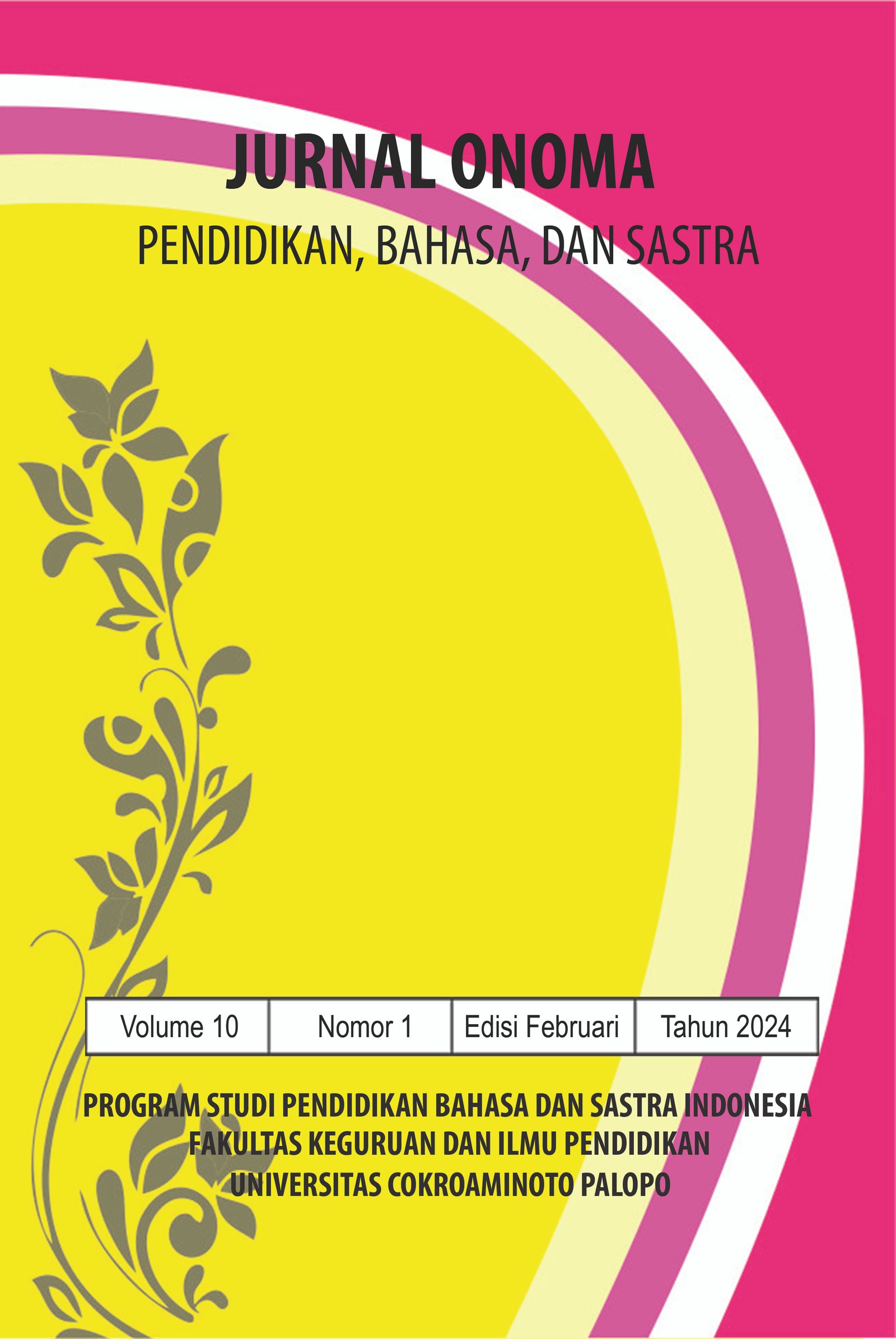Increasing Reading Comprehension through the Use of Kaili Folktales
https://doi.org/10.30605/onoma.v10i1.3236
Keywords:
Reading Comprehension, Kaili Folktales, Pre-ExperimentalAbstract
The research employed Kaili folktales to increase reading comprehension of the ninth grade students at SMP Negeri 20 Palu. The primary research question is whether incorporating Kaili folktales through this environment my increase students’ reading comprehension. The research used a pre-experimental design in a quantitative approach that included a pre-test, treatment, and post-test. The research population was the 87 ninth grade students of SMP Negeri 20 Palu, with 29 students as sample from class IX B selected through purposive sampling. The research instrument was a reading comprehension test that was given as a pre-test and post-test. Data analysis was conducted using SPSS 22. The results showed that using Kaili folktales increased students’ reading comprehension significantly, as evidenced by a higher mean score in the post-test compared to the pre-test (61.972>34.221). The p-value determined of 0.00, which is lower than the alpha value of 0.05, supported the conclusion that applying of Kaili folktales increased students’ reading comprehension statistical significantly. As a result, the researcher concluded that Kaili folktales might effectively increase students’ reading comprehension of the ninth grade at SMP Negeri 20 Palu
Downloads
References
Brown, H. D. (2004). Language Assessment: Principles and Classroom Practices. Pearson Education, Inc.
Elleman, A. M., & Oslund, E. L. (2019). Reading Comprehension Research: Implications for Practice and Policy. Policy Insights from the Behavioral and Brain Sciences, 6(1), 3–11. https://doi.org/10.1177/2372732218816339
Kramsch, C. (2013). Teaching Culture and Intercultural Competence. NJ: Blackwell Publishing.
Latief, J. A., Listiqowati, I., & Muis, A. A. (2021). Development of Teaching Material Supplement for Geography Subject Based on Local Wisdom of Kaili Da’a in Sigi Regency, Central Sulawesi. International Journal of Educational Research & Social Sciences, 374–382.
Lwin, S. M. (2015). Using Folktales for Learning Teaching. Malaysian English Language Teaching Association (MELTA), 44(2), 74–83. www.melta.org.my
Mukundan, J. (2003). Reading on ELT Material. Universiti Putra Malaysia Press.
Putra, I. M. J., & Komang, I. N. W. (2021). Pengembangan Multimedia Interaktif Berorientasi Pendekatan Kontekstual Materi Sumber Energi Pada Pembelajaran IPA Kelas IV SD. Jurnal Edutech Undiksha, 9(1). https://doi.org/10.23887/jeu.v9i1.32356
Richards, J. C., & Renandya, W. A. (2002). Methodology in Language Teaching: An Anthology of Current Practice. Cambridge University Press.
Saadatnia, M., Ketabi, S., & Tavakoli, M. (2017). Levels of Reading Comprehension Across Text Types: A Comparison of Literal and Inferential Comprehension of Expository and Narrative Texts in Iranian EFL Learners. Journal of Psycholinguistic Research, 46(5), 1087–1099. https://doi.org/10.1007/s10936-017-9481-3
Siradjuddin, Z. (2020). “Pehakovia” and House Forming Strategy and To Kaili Settlement in Central Celebes Indonesia. Advances in Anthropology, 10(01), 1–16. https://doi.org/10.4236/aa.2020.101001
Skinner, B. F. (1957). Verbal behavior. Appleton-Century-Crofts. https://doi.org/10.1037/11256-000
Westland, E. (1993). Cinderella in the Classroom: Children’s Responses to Gender Roles in Fairy-Tales. Gender and Education, 5(3), 237–249.
Yusuf, O. H. (2017). Impact of the Teacher’s Use of Folktale on the Perfomance of Pupils in Reading Comprehension in Primary School in Kaduna State, Nigeria. The Online Journal of Quality in Higher Education, 4(4), 25–32
Downloads
Published
How to Cite
License
In submitting the manuscript to the journal, the authors certify that:
- They are authorized by their co-authors to enter into these arrangements.
- The work described has not been formally published before, except in the form of an abstract or as part of a published lecture, review, thesis, or overlay journal.
- That it is not under consideration for publication elsewhere,
- That its publication has been approved by all the author(s) and by the responsible authorities – tacitly or explicitly – of the institutes where the work has been carried out.
- They secure the right to reproduce any material that has already been published or copyrighted elsewhere.
- They agree to the following license and copyright agreement.
License and Copyright Agreement
Authors who publish with Onoma Journal: Education, Languages??, and Literature agree to the following terms:
- Authors retain copyright and grant the journal right of first publication with the work simultaneously licensed under Creative Commons Attribution License (CC BY 4.0) that allows others to share the work with an acknowledgment of the work's authorship and initial publication in this journal.
- Authors are able to enter into separate, additional contractual arrangements for the non-exclusive distribution of the journal's published version of the work (e.g., post it to an institutional repository or publish it in a book), with an acknowledgment of its initial publication in this journal.
- Authors are permitted and encouraged to post their work online (e.g., in institutional repositories or on their website) prior to and during the submission process, as it can lead to productive exchanges, as well as earlier and greater citation of published work.

















